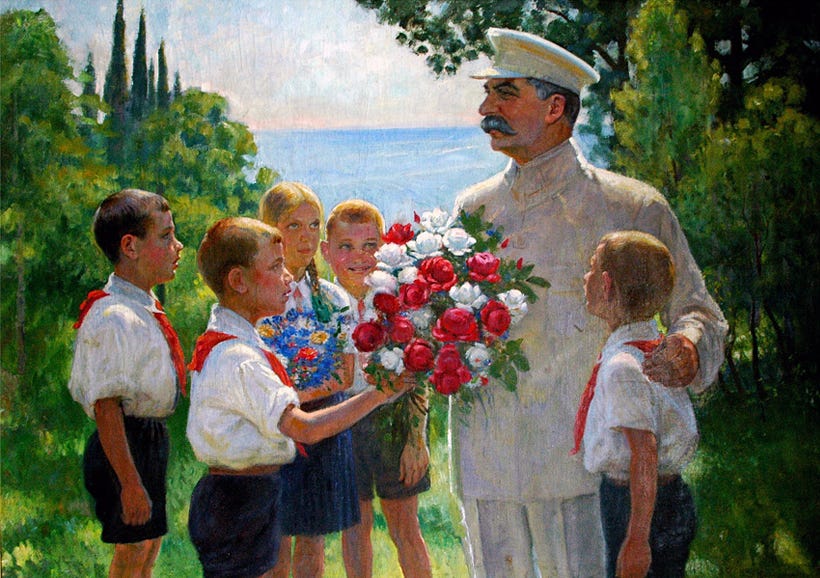No Roses for Stalin
Oh, do I look familiar? My doppelgänger is a girl in a propaganda painting from 1949.
At a certain age I’ve long passed, every face you see starts to look like a face you’ve already seen. A person you already know.
Sometimes the resemblance is incomplete. You have the eyes of my friend’s daughter. The cheeks, nose, and overall vibe of my old coworker. A jawline like that one actor, has anyone ever told you that?
Sometimes, more excitingly, you find a straight up doppelgänger.
Do you have one? I do.
My doppelgänger is a girl in a propaganda painting.
In 11th grade, I was sitting in AP US History before the bell rang when a girl I barely knew ran in shouting my name. She wasn’t in my class, but somehow she knew where to find me. “Savannah! You’re in my book,” she said, catching her breath. She held up her AP Art History textbook to show me “Roses for Stalin,” by Boris Vladimirski, 1949. My classmates gathered around. Everyone gasped.
The painting features Stalin, a group of four boys, and one girl with blond braids. Me.
Look at these children, myself included, handing roses to the dictator in a pastoral landscape. How lovely. How saccharine. How false.
The painting belongs to the Socialist Realism movement: a government-sanctioned and mandated artistic aesthetic. Life in the Soviet Union, but make it cute. Make it idyllic. And you might not get censored!
I’m zero parts Russian, and I don’t particularly look it, although a few years ago, in a doctor’s office in Burbank, a Russian woman begged me to translate for her. This was before Google translate got really good, so I could only shake my head. Sorry, I don’t, I’m not.
When my grandpa got dementia, his personality changed and so did his stories. They were new to me, but they were old, and he repeated them on a loop. My aunts who saw and cared for him regularly could interpret them after just two words.
“You…” he said when I visited on my own, the summer I turned 17. “Snow…”
“He’s talking about when your sister was little, and visited your grandparents, and they put her in a big snowsuit to go outside.”
He thought that story might be about me. I didn’t protest. My sister had been too little to remember it anyway, so why not borrow the memory?
In the elevator at the assisted living facility, a worker said to him, “Now look at your beautiful visitor!”
He smiled. “Thank you.”
“Oh, do you have something to do with this?” She teased.
He nodded, yes, because she (I) was… well, his son was…
“She’s your granddaughter?”
He nodded. Words and memory had failed, but still, she’d understood.
Later, he asked me, “Are you the one who dances?” I was, he got it right. We both beamed. So pleased to know and be known.
Another of his stories, though, is why I bring this up. He told me about his mother, who’d grown up in Germany. “She ran and ran through the forest,” he said. “Away from That Bad Man.”
“Who?” I asked. The aunts hadn’t heard this one and couldn’t help.
“That Bad Man,” he said. He started to get agitated. Said it again. That Bad Man. Why didn’t I know him?
There were some context clues, places mentioned, dates, and I wanted to be helpful. I threw out a few dictators’ names, historically inaccurate, timeline wise, but I was trying. “Hitler? Lenin? Stalin?”
And to Stalin, he said yes. “Yes. That Bad Man.” He nodded, certain. Pleased. Grateful. Finally, he was understood. A family secret, passed down.
“Stalin chased your mom through the forest?” I asked.
He agreed.
I agreed.
I never heard this story again.
I tried to fact check. On those dates, pre-WWI, in that part of the continent, it couldn’t have been Stalin. Not him, personally, or even one of his lackeys. The Bad Man remains a mystery. But when I see my face oil painted into a propaganda painting, I think, “No.” No roses for That Bad Man. Not with my face.





So well portrayed. Reminded me of a story my grandfather, who would have been about the same age as your great grandmother, told me about the pogroms in the region then called Austria-Poland, which caused him with my grandmother and 2 children to flee in the early 1900's.
Just got chills from your last sentence! Another beautiful essay. What a nice tribute to your grandfather. Keep the essays coming!